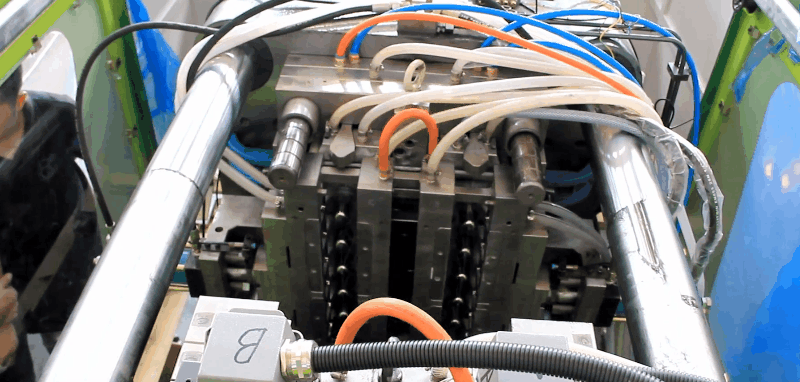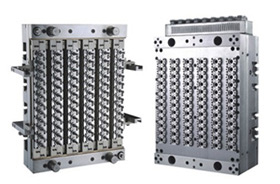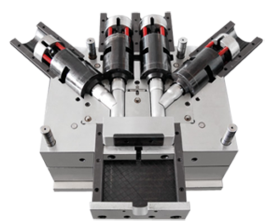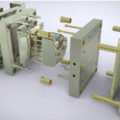Details of the Process for Injection Molding Machines

The earliest injection moulding machines were of the plunger type and there are still many of these machines in use today. A pre-determined quantity of moulding material drops from the feed hopper into the barrel. The plunger then conveys the material along the barrel where it is heated by the conduction from the external heaters. The material is then plasticised under pressure so that it may be forced through the nozzle into the mould cavity. In order to split up the mass of the material in the barrel and improve the heat transfer, a torpedo is fitted in the barrel . But there are few disadvantages in this type of machine i.e. it is difficult to produce consistent mouldings. The main problems are:
1. There is little mixing or homogenization of the molten plastic.
2. It is difficult to meter accurately the shot size. Since metering is on a volume basis, any variation in the density of the material will alter the shot weight.
3. Since the plunger is compressing material which is in a variety of forms the pressure at the nozzle can vary quite considerably from cycle to cycle.
4. The presence of the torpedo causes a significant pressure loss.
5. The flow properties of the melt are pressure sensitive and since the pressure is erratic, this amplifies the variability in mould filling.
Few of these disadvantages of the plunger machine may be overcome by using a pre-plasticising system. This type of machine has two barrels. Raw material is fed into the first barrel where an extruder screw or plunger plasticises the material and feeds it through a non-return valve into the other barrel. A plunger in the second barrel then forces the melt through a nozzle and into the mould. In this system there is much better homogenization because the melt has to pass through the small opening connection the two barrels.
The shot size can also be metered more accurately since the volume of the material fed into the second barrel can be controlled by a limit switch on its plunger. Another advantage is that there is no longer a need for the torpedo on the main injection cylinder. But this type of machine is seldom used because it is considerably more complicated and more expensive than necessary.
Nowadays the market is dominated by the reciprocating screw type of the injection moulding machine. This was a major breakthrough in machine design and yet the principle is simple. An extruder type screw in a heated barrel performs a dual role. On the one hand it rotates in the normal way to transport, melt and pressurize the material in the barrel bUt it is also capable, whilst rotating, of moving forward like a plunger to inject melt into the mould. There are a number of important features in reciprocating screw injection moulding machines and these will now be discussed here.
The screws in these machines are basically the same as those used in theextrusion. The compression ratios are usually in the range 2.5: to 4:1 and the most common UD ratios are in the range 15 to 20. Some screws are capable of injecting the plastic at pressures up to 200MN/m. One important difference from a extruder screw is the presence of a back-flow check valve at the end of the screw. The purpose of this valve is to stop any back flow across the flights of the screw when it is acting as a plunger. When material is being conveyed forward by the rotation of the screw, the valve opens. One exception is when injection moulding heat-sensitive materials such as PVC. In such cases there is no check valve because this would provide sites where material could get clogged and would degrade.
The most recent development in the introduction of a vented barrel for injection moulding machines. It has the major advantage of permitting materials to be moulded without pre-drying.
The heaters are normally of the electrical resistance type and are thermostatically controlled using thermocouples. The nozzle is screwed into the end of the barrel and provides the means by which the melt can leave the barrel and enter the mould. It is also a region where the melt can be heated both by friction and conduction from a heater band before entering the relatively cold channels in the mould. Contact with the mould causes heat transfer from the nozzle and in cases where this is excessive it is advisable to withdraw the nozzle from the mould during the screw-backpart of the moulding cycle. Otherwise the plastic may freeze off in the nozzle.
There are several types of nozzle.
1. Open nozzle: The simplest is an open nozzle. This is used whenever possible because pressure drops can be minimized and there are no hold up points where the melt can stagnate and decompose. But in case of low viscosity of the melt then leakage occurs. The solution is to use a shut-off nozzle of which there are many types.
2. External shut-off nozzle: This is the nozzle which is shut-off by external means.
3. Needle shut-off nozzle: This is the nozzle with a spring loaded needle valve which opens when the melt pressure exceeds a certain value or alternatively when the nozzle is pressed up against the mould. Most of the shut-off nozzles have the disadvantage that they restrict the flow of the material and provide undesirable stagnation sites. For this reason they should not be used with heat sensitive materials such as PVC.









